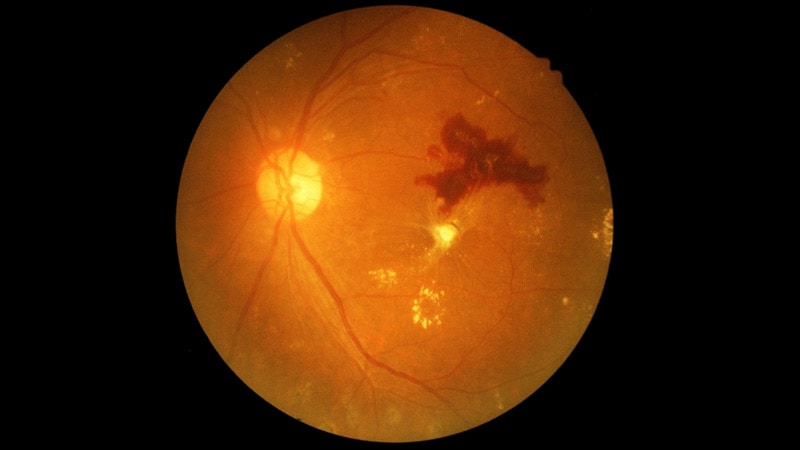STOCKHOLM — A large database analysis of more than 370,000 patients has found that glucagon-like peptide 1 (GLP-1) receptor agonists do not seem to increase the risk for diabetic retinopathy.
The new findings, presented at the American Society of Retina Specialists (ASRS) 2024 Annual Meeting, cast doubt on results from a pivotal clinical trial that had influenced GLP-1 use in patients at a risk for the eye condition, experts said.
“The GLP-1 receptor agonist medications do not confer an increased risk relative to the DPP-4 inhibitors [dipeptidyl peptidase-4 i] and sulfonylureas,” Andrew Barkmeier, MD, a retina specialist at Mayo Clinic in Rochester, Minnesota, said. “And the relative interclass risks were similar at both shorter and longer durations of use.”
Barkmeier led the retrospective study of 371,698 adults aged 21 years and older in US commercial, Medicare Advantage, and Medicare fee-for-service insurance plans. The trial subjects all had type 2 diabetes and a moderate risk for cardiovascular disease, but no history of diabetic retinal disease, and had started treatment with a GLP-1, DPP-4 inhibitor, sodium-glucose cotransporter 2 (SGLT2) inhibitor, or sulfonylurea agent. The primary endpoint was time to first treatment for sight-threatening retinopathy, defined as either diabetic macular edema or proliferative diabetic retinopathy.
Study Findings
“SGLT2 inhibitor use was associated with a lower risk of sight-threatening retinopathy compared to other classes of the glucose-lowering medications, with the relative risk reduction ranging from 21% to 39%,” Barkmeier reported.
The probability of treatment with an SGLT2 inhibitor was 0.3% at 2 years and 0.7% at 5 years. For the other drug classes, those respective numbers were 0.4% and 1% for a GLP-1, 0.4% and 0.9% for a DPP-4 inhibitor, and 0.5% and 1.2% for a sulfonylurea agent, respectively.
Barkmeier said the 2016 SUSTAIN-6 trial evaluating cardiovascular outcomes with semaglutide had raised concerns about the risks for diabetic retinopathy with GLP-1 agents. The SUSTAIN-6 investigators reported rates of retinopathy complications were 76% higher in patients taking semaglutide. Labeling for Wegovy and Ozempic, commercial formulations of semaglutide, carries a warning about the potential for complications of diabetic retinopathy.
“As with any other medication that has any type of listing in their label about ocular complications or concerns, and with media reports of worsening diabetic retinopathy, we get asked by patients and prescribing doctors, ‘Is it OK for this patient to take this medication?'” Barkmeier told Medscape Medical News. “The answer that we’re seeing here is that there’s not an increased risk of starting these GLP-1 medications or SGLT2 medications compared to prior therapies.”
One explanation for the varying results between Barkmeier’s study and SUSTAIN-6 is the latter enrolled patients at a high risk for cardiovascular complications. “Most people in the real world are in a different situation,” he said. “This study identified patients in more routine practice situations.”
Another explanation is that early worsening of diabetic retinopathy in the clinical trial may have resulted from rapid improvement in levels of blood glucose, Barkmeier said. That association has been borne out in two older studies: A 1998 analysis by the Diabetes Control and Complications Trial Research Group and the Oslo study in 1985.
Barkmeier said more complete answers may be forthcoming when data from the FOCUS trial arrive. That study, which is evaluating how semaglutide affects diabetic eye disease compared with placebo, is due for completion in 2027.
Message for the Clinic
The findings clarify advice retina specialists can give to their patients on glucose-control medications, David Boyer, MD, a retina specialist at Retina-Vitreous Associates Medical Group in Southern California, told Medscape Medical News.
“I believe the talk can give us more confidence in following our diabetic patients,” Boyer said, noting that the study further confirms that diabetes medications have a similar effect on the progression of diabetic retinopathy, “although SGLT2s appears to be slightly safer than the other drugs,” Boyer said.
However, Boyer said the researchers did not evaluate patients based on how much their glucose levels improved.
“Patients who have had a significant decrease of hemoglobin A1c were not followed separately,” he said. GLP-1s have been linked to nonarteritic anterior ischemic optic neuropathy, but the new study did not look at that association.
Barkmeier had no relevant disclosures. Boyer disclosed financial relationships with Regeneron Pharmaceuticals, Genentech/Roche, EyePoint Pharmaceuticals, Novartis, Bayer, and Allergan/AbbVie.
Richard Mark Kirkner is a medical journalist based in the Philadelphia area.
>>> Read full article>>>
Copyright for syndicated content belongs to the linked Source : Medscape – https://www.medscape.com/viewarticle/are-glp-1s-bad-retinas-2024a1000djk
